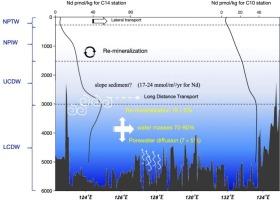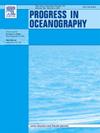菲律宾海深部稀土元素来源的量化:数值模拟和野外观测的启示
IF 3.6
3区 地球科学
Q1 OCEANOGRAPHY
引用次数: 0
摘要
尽管稀土元素(REE)作为研究海洋过程的重要工具,但各种来源对深海REE分布的定量贡献仍然缺乏限制。本文采用数值模拟和现场观测相结合的方法,研究了菲律宾海深水中稀土元素的来源和输运机制。研究结果表明,北太平洋热带水(NPTW)的侧向输送导致上层水柱中稀土元素含量相对较低。在中深度(1500 m),稀土元素分布受下沉有机颗粒再矿化控制,与表观氧利用(AOU)呈正相关,而在上环极深水(UCDW, 1500 - 3000 m),以水团混合为主,占80 - 100%。在较深的水域(3500米),水团混合、孔隙水扩散和再矿化分别贡献了大约70 - 80%、7±5%和19±5%的钕(Nd)收支,尽管这些贡献可能因地区而异。在2500 ~ 3500 m之间,观察到REE浓度显著增加,估计来自成岩物质来源的输入通量在17 ~ 24 mmol Nd m−2 yr−1之间。这些浓度升高可能受到深海洋流、横向输送和季节变化的影响,从而影响稀土元素的空间分布和输送距离。我们的研究结果表明,深海中溶解稀土浓度[dREE]可能受到斜坡源物质的影响,而不是保持不变。最深层Nd的底部扩散通量估计为0.6±0.4pmol cm−2 yr−1。模型模拟进一步表明,孔隙水对溶解Nd的贡献高达7±5%,在4000 m以上深度,孔隙水对ΔNd的影响超过10%。这些发现表明,孔隙水向海底海水的扩散将对未来深海微量金属生物地球化学循环的研究具有重要意义。本文章由计算机程序翻译,如有差异,请以英文原文为准。

Quantifying the sources of REE in the deep Philippine Sea: Insights from numerical modeling and field observations
Despite the importance of rare earth elements (REE) as tools for studying ocean processes, the quantitative contributions of various sources to deep-ocean REE distributions remain poorly constrained. In this study, we combine numerical modeling and in-situ observations to investigate the sources and transport mechanisms of REE in the deep waters of the Philippine Sea. Our findings indicate that REE concentrations are relatively low in the upper water column, primarily due to lateral transport from North Pacific Tropical Water (NPTW). At intermediate depths (<1500 m), REE distributions are controlled by the remineralization of sinking organic particles, as evidenced by a strong positive correlation with apparent oxygen utilization (AOU), while in the Upper Circumpolar Deep Water (UCDW, 1500–3000 m), water mass mixing dominates, accounting for 80–100 %. In deeper waters (>3500 m), water mass mixing, porewater diffusion, and remineralization contribute approximately 70–80 %, 7 ± 5 %, and 19 ± 5 % to the neodymium (Nd) budget, respectively, though these contributions may vary regionally. Between 2500 and 3500 m, significant increases in REE concentrations were observed, with estimated input fluxes from lithogenic material sources ranging from 17 to 24 mmol Nd m−2 yr−1. These elevated concentrations are likely influenced by deep ocean currents, lateral transport, and seasonal variations, consequently affecting the spatial distribution and transport distance of REE.
Our results suggest that dissolved REE concentrations [dREE] in the deep ocean may be influenced by slope-derived materials rather than remaining constant. The bottom diffusion flux of Nd from the deepest layer is estimated at 0.6 ± 0.4pmol cm−2 yr−1. Model simulations further indicate that the porewater contributes up to 7 ± 5 % of the dissolved Nd, with its influence on ΔNd exceeding 10 % at depth beyond 4000 m. These findings suggest that the diffusion of porewater into the bottom seawater would play a highly significant role in advancing future research on deep-sea trace-metal biogeochemical cycling.
求助全文
通过发布文献求助,成功后即可免费获取论文全文。
去求助
来源期刊

Progress in Oceanography
地学-海洋学
CiteScore
7.20
自引率
4.90%
发文量
138
审稿时长
3 months
期刊介绍:
Progress in Oceanography publishes the longer, more comprehensive papers that most oceanographers feel are necessary, on occasion, to do justice to their work. Contributions are generally either a review of an aspect of oceanography or a treatise on an expanding oceanographic subject. The articles cover the entire spectrum of disciplines within the science of oceanography. Occasionally volumes are devoted to collections of papers and conference proceedings of exceptional interest. Essential reading for all oceanographers.
 求助内容:
求助内容: 应助结果提醒方式:
应助结果提醒方式:


